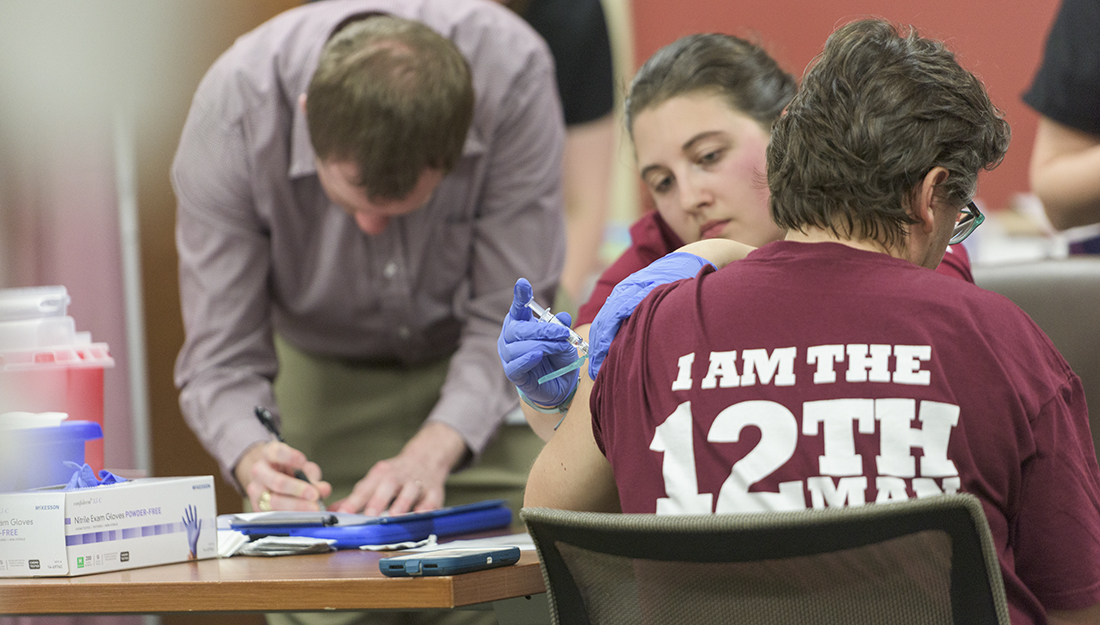- Mary Leigh Meyer
- Medicine, Nursing, Pharmacy, Public Health, Show on VR homepage, Trending, Uncategorized
Students practice mass inoculation during flu vaccine clinics
Hundreds of faculty and staff from Texas A&M University receive free flu shots from Health Science Center students

Flu Vaccine Clinic_A student administers a flu shot to a Texas A&M employee
Partnering with the Texas A&M Division of Human Resources and Organizational Effectiveness, the components of the Texas A&M University Health Science Center plan to administer 2,000 free influenza (flu) shots to local Texas A&M System employees, their eligible dependents who are 6 months or older and retirees covered by the A&M Care Plan (Blue Cross Blue Shield of Texas). They are offering various clinics at different locations throughout the month of October. Participating in this year’s flu clinics are the Texas A&M University Health Science Center’s Office of Interprofessional Education & Research, Texas A&M College of Medicine, Texas A&M College of Nursing, Texas A&M College of Pharmacy, Texas A&M School of Public Health and Texas A&M Health Family Care.
“The flu clinics are a great way for our students to give back to the Texas A&M community,” said Greg Hartman, vice chancellor for strategic initiatives at The Texas A&M University System, interim senior vice president of the Texas A&M University Health Science Center. “We are offering five flu vaccine clinics this year and we expect to give hundreds of faculty and staff members from The Texas A&M University System their flu shot.”
How do the flu vaccine clinics work?
“The start of flu season happens around the months of October and November,” said Suzanne Van, MSN, clinical assistant professor at the College of Nursing who has been involved in the planning for the clinics. “Everyone should aim to get their flu shot early to be protected through the end of flu season, which is around March.”
For the 2019 flu season, the partners put on the five flu shot clinics listed below.
- October 1: Walk-in Flu Vaccine Clinic, 1 p.m. to 5 p.m., Student Rec Center
- October 10: Walk-in Flu Vaccine Clinic, 8 a.m. to 5 p.m., General Services Complex (GSC)
- October 18: Drive-thru Flu Vaccine Clinic, 11 a.m. to 6 p.m., Fan Field Parking Lot off Research Parkway
- October 24: Walk-in Flu Vaccine Clinic, 8 a.m. to 5 p.m., Rudder Exhibit Hall
- October 25: Walk-in Flu Vaccine Clinic, noon to 6 p.m., Health Professions Education Building (HPEB) LL 43A & B
“Our Texas A&M Health Science Center faculty advise and monitor the Health Science Center students through the process of administering the flu shots,” Van said. She expects over 100 Health Science Center students, staff, and faculty to participate in the flu clinics.
The importance of a flu shot
“Everyone 6 months of age and older should get a flu vaccine every season,” Van said. “Regardless whether people consider it to be a ‘bad’ flu season, the flu kills people every year.” She encourages everyone who can be vaccinated to get the flu shot because “one death from the flu is one death too many.”
Children ages 6 months to 8 years old should have two vaccines the first time they are vaccinated against influenza. These vaccines should be given at least four weeks apart. Similarly, those at high risk, such as pregnant women, older adults, children and those who have weakened immune systems should be sure to get vaccinated, according to Van.
Within the past few years, the flu vaccine has been updated to cover the evolved strains, and new recombinant vaccines are available for those who have egg allergies. If you have any concern about whether you can get the flu shot, speak with your health care provider.
An interprofessional approach to mass inoculation trainings
“Many times, students of the health professions are educated in silos, or without much involvement with the other health professions,” Van said. “As a result, they do not necessarily understand how to work with each other.” Because the Health Science Center has interprofessional events like the flu clinic and Disaster Day, the students learn to work together collaboratively to provide the best possible care. They organically get that critical interprofessional experience on a level where all health professions are the same.
“In the case of an emergency mass inoculation, the health professions are going to need to work together and work together well,” said Martin Mufich, director of disaster preparedness, response and recovery in the Office of Interprofessional Education and Research at the Health Science Center. “These flu vaccine clinics let us iron out and practice the process of a mass inoculation.”
The drive-thru flu vaccine clinic
In a situation where a mass inoculation is needed, the drive-thru flu vaccine clinic is great practice. “We limit the exposure of potentially infected individuals, because we do not want hundreds of people to pass through the same room to get their vaccination,” Mufich explained. “When people can stay contained in their car, they face less exposure and the pathogen is less likely to spread.”
However, for now, the drive-thru vaccine clinic is simply a convivence factor. “Because we are not in an emergency inoculation situation, the faculty and staff who get vaccinated find it incredibly convenient to get their flu shot without getting out of their car,” Van stated. “On the disaster preparedness level, it is great practice for everyone at the Health Science Center, but, at the same time, it is helpful to our clinic attendees. The more people in our community that get their flu shot, then the more protected we all are from the flu.”
If you are looking for more information about the upcoming flu vaccine clinics, visit the webpage.
Media contact: media@tamu.edu


